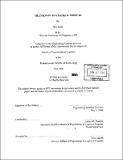Transition to clicks & mortar
Author(s)
Endy, Ben, 1973-
DownloadFull printable version (3.985Mb)
Alternative title
Transition to clicks and mortar
Other Contributors
Massachusetts Institute of Technology. Engineering Systems Division.
Advisor
James M. Masters.
Terms of use
Metadata
Show full item recordAbstract
The e-commerce boom has had a ripple effect on the way bricks-and-mortar retail stores operate their business. Bricks-and-mortar stores not only have to compete with one another in the physical world; they now have to compete with the pure Internet players. However, there are several issues that bricks-and-mortar stores must face before they can launch their online operations. The transformation strategy must be carefully planned. In addition, bricks-and-mortar stores must face certain challenges those pure Internet players seldom or never encounter. First, they have to recognize that e-commerce users have become an important segment of consumers; if they decide to go online, they must take the endeavor seriously. Second, they need to determine the best way to integrate online and physical operations. On the other hand, pure Internet players have also realized the benefits of a physical presence. Many have discovered that having outlets can improve their customers' overall shopping experience. For instance, Gateway Computers started as a catalog ordering company, but now the company has stores all over the country which serve as showrooms where customers can try out the computers. This combination has significantly increased Gateway's sales. This thesis will explore the factors that lead to the need for "clicks-and-mortar". Furthermore, it will point out the challenges facing clicks-and-mortar companies and discuss them in detail. It will then elaborate on the transition process and then create three clicks-and-mortar models. Finally, it will make a detailed comparison of the three models in order to determine their benefits and limitations.
Description
Thesis (M.Eng.)--Massachusetts Institute of Technology, Engineering Systems Division, 2000. Includes bibliographical references (leaves 44-46).
Date issued
2000Department
Massachusetts Institute of Technology. Engineering Systems DivisionPublisher
Massachusetts Institute of Technology
Keywords
Engineering Systems Division.